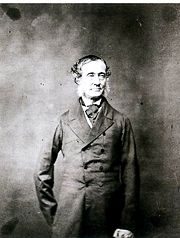Shanghai – First Impressions No.2 – Alexander Michie on the Arrival of Sir Rutherford Alcock at Shanghai, 1846
Posted: August 21st, 2013 | No Comments »Congenial Recreation – Rutherford Alcock – 1846
Alexander Michie (1833-1902) was born in Earlsferry, Fifeshire though virtually his entire adult life was connected with the China trade while he was also an intrepid traveller across China, the local agent for Jardine Matheson in Tientsin and the editor of the Tientsin-based newspaper Chinese Times. For a time he acted as the Chairman of the Chamber of Commerce at Shanghai. In his obituary the Royal Geographic Society in London noted, ‘…the work which he subsequently gave to the world, under the title of An Englishman in China, is valuable as containing the matured judgment on the modern relations between East and West of one who had lived in the Celestial Empire for over forty years.†In this excerpt he describes the arrival of Rutherford Alcock in Shanghai.
Sir Rutherford Alcock KCB (1809-97) (pictured above) was the son of a London physician who himself became an army surgeon. In 1844 he was appointed British Consul at Foochow (Fuzhou) before moving to the British Consulate at Shanghai where he remained until 1846. His most notable contribution to Shanghai was to formally lay out the borders of the British Settlement. In 1848 he was appointed Consul General to Japan, the following year being made Minister Plenipotentiary and opening the first British Legation in Japan as well as becoming the first foreigner to climb Mount Fuji. In 1865, after a spell back in England, and then a return to Japan, he was transferred to Peking, where he represented the British government until 1871 and his retirement though he remained active as a President of the Royal Geographical Society.
Michie on Alcock’s arrival
To ground thus wisely prepared Mr Alcock succeeded in the autumn of 1846. His four months at Amoy and eighteen at Foochow were only preparatory for the real work which lay before him in the consulate at Shanghai, whither he carried in his train the interpreter Parkes (1), with whom he had grown accustomed to work so efficiently. Shanghai by this time was already realising the position assigned to it by nature as a great commercial port, and the resident community, 120 Europeans all told, was already forming itself into that novel kind of republic which is so flourishing today, while its commercial interests were such as to give its members weight in the administration of their own affairs as well as in matters of public policy.
Â
The level country round Shanghai was, as we have said, very favourable for excursions by land and water, affording tourists and sportsmen congenial recreation. The district was in those days remarkably well stocked with game. Pheasants of the “ring necked†variety, now so predominant in English preserves, abounded close up to the city wall, and were sometimes found in the gardens of the foreign residents. Snipe, quail, and wildfowl were plentiful in their season, the last named in great variety. All classes of the foreign community took advantage of the freedom of locomotion which they enjoyed. Newly arrived missionaries, no less than newly arrived sportsmen were encouraged by the ease and safety with which they cold prosecute their vocation in the towns and villages accessible from Shanghai. Within the radius authorised by treaty the foreigners soon became familiar objects in a district which is reckoned to support a population as dense as that of Belgium. Not only did friendly relations exist, but a wonderful degree of confidence was established between the natives and foreign tourists. It was not the custom in those days for foreigners to carry money, the only coinage available being of a clumsy and non-portable character. They paid their way by “chits†or orders upon their comprador (2), and it was not uncommon for them in those early days to pay for supplies during their excursions into the interior by a few hieroglyphics pencilled on a scrap of paper, which the confiding peasant accepted in perfect good faith, and with so little apprehension that sometimes a considerable interval would elapse before presentation of these primitive cheques – until perhaps, the holder had occasion to make a journey to Shanghai.
Alexander Michie, The Englishman in China – During the Victorian Era – Volume 1, (William Blackwood & Sons, 1900, Edinburgh)
1) The remarkable Harry (later Sir Harry) Parkes (1828-1885) who arrived in Macao in 1841 to see his cousin, Mary Wanstall Gützlaff (the wife of the Pomeranian missionary Karl Gützlaff). After learning Chinese he accompanied Sir Henry Potinger to witness the signing of the treaty of Nanking (which created the treaty port of Shanghai) on board the British warship HMS Cornwallis in August 1842. He went on to become Consul at Amoy (Xiamen), Canton (Guangzhou) and Shanghai before being appointed British Minister in Japan, a post he held for 18 years. In 1890, the Duke of Connaught unveiled a statue of Parkes on Shanghai’s Bund.
2) Chits were signed notes to pay that were redeemed at the end of the month by creditors. Compradors were Chinese agents employed by the foreign trading companies as go-betweens and extremely powerful in their own right.

Leave a Reply